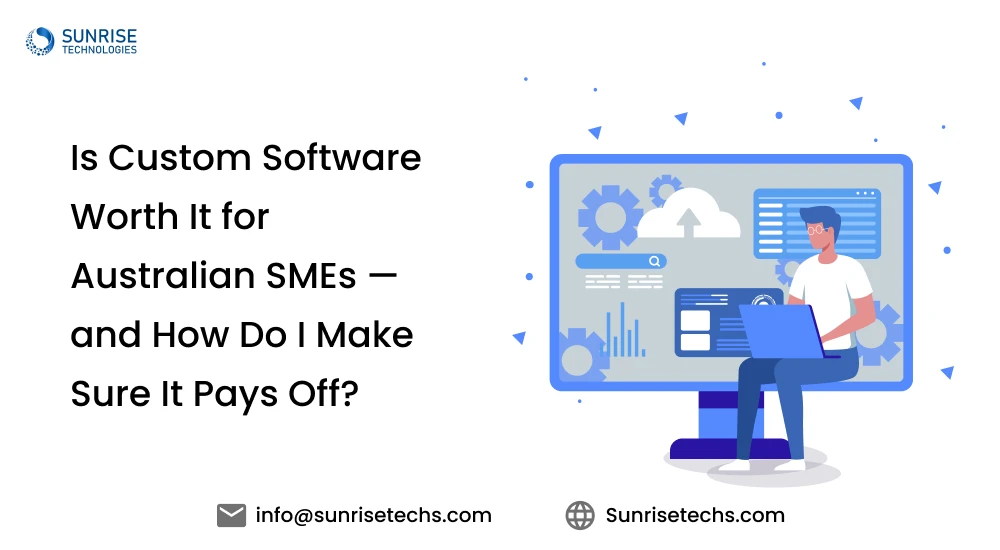
Is Custom Software Worth It for Australian SMEs — and How Do I Make Sure It Pays Off?
Oct 7, 2025
If you’re running an SME in Australia, you’ve probably asked yourself at least once:
“Should I invest in custom software… or just stick with off-the-shelf tools?”
“Will it actually pay off — or is it just another tech cost I’ll regret?”
These aren’t small questions. Whether you’re running a construction business in Perth, a logistics company in Sydney, or a healthcare practice in Melbourne, the wrong software decision can eat into your margins, slow your team down, and put you behind competitors who are moving faster.
At Sunrise Technologies, we work with Australian businesses every day who are stuck at this crossroads. They want to know if custom software development or AI-powered solutions are worth the investment. They’re worried about cost overruns. They want real ROI. And they want confidence that their business won’t be locked into tech that doesn’t scale. So let’s break it down in detail — no jargon, no sugar-coating. Just practical insights you can use to make the right decision.
How Can Bespoke Software Give an SME a Competitive Edge in the Australian Market?
Let’s start with the big question: Why not just use off-the-shelf software?
It’s interesting. Platforms like Xero, MYOB, or even generic CRM systems feel “good enough.” But here’s the issue:
- Off-the-shelf tools are built for the average global user, not the specifics of your industry in Australia.
- They force you to adapt your processes to the software instead of the other way around.
- Competitors using the same tools aren’t creating an edge — they’re stuck in the same box.
Custom software solutions are built to map your unique workflows, compliance needs, and growth goals.
For example:
- A custom inventory system for an Australian retail SME can sync real-time data with suppliers, forecast seasonal demand (based on local patterns), and even handle GST rules correctly.
- A construction SME in Perth might use bespoke project management software that tracks subcontractor compliance, integrates with local council approval systems, and generates risk dashboards for site managers.
- A healthcare SME in Melbourne could deploy custom patient management software that integrates seamlessly with Medicare, telehealth, and AI-driven appointment scheduling.
That’s not just convenience — that’s a competitive advantage. You’re not fighting with software. You’re moving faster because the software is literally built for how you run. And in an economy where margins are tight and customer expectations are high, that’s the edge SMEs need.
Find out exactly how much your SME’s bespoke solution will cost with zero guesswork. Fast, accurate, and tailored for your business.
How to Calculate the ROI of Custom Software vs Manual Processes
When SMEs think about custom software development, the first question is always “How do I know if it’s worth the money?”
The simplest way to answer that is: compare the cost of inefficiency today with the cost of building software tomorrow. Let’s take a real-world SME scenario in Australia:
- Manual Process Example: A mid-sized construction firm with 50 employees spends 12 hours a week manually entering job schedules, approvals, and supplier invoices. At an average $40/hour wage, that’s $24,960 a year wasted on just admin re-entry.
- Custom Software Scenario: A tailored job scheduling + invoicing app costs, say, $90,000 to develop. If it saves $25,000 per year in wasted labour, plus prevents delays (worth another $40,000 annually), the ROI is clear — breakeven in less than 2 years, and ongoing savings after.
That’s without even calculating “hidden ROI”: fewer mistakes, faster approvals, happier clients, and stronger compliance.
For example:
ROI (%) = (Annual Savings + Additional Revenue Gains – Development & Maintenance Cost) ÷ Development Cost × 100
Most SMEs are surprised when they run the numbers — even “expensive” bespoke software ends up paying for itself faster than off-the-shelf tools with licensing fees that never end.
How Can You Avoid Cost Overruns in Australian Software Projects?
This is the elephant in the room. We’ve all heard stories of software projects going 2x or 3x over budget. So how do you, as an SME, protect yourself?
1. Start with a clear scope, not vague ideas
- “We want a mobile app” is vague.
- "We need an app where customers can book, pay, and track orders in real time"
2. Ask for a phased delivery
- Don’t pay for a 12-month mega-build upfront.
- Instead, build in milestones every 4–6 weeks. This way, you see progress and keep budgets in check.
3. Work with a local software development company in Australia
- Offshore dev might look cheaper upfront, but mismatched requirements and rework blow costs out.
- A Perth-based software developer who understands Australian compliance and market needs will actually save you money long term.
4. Factor in maintenance early
- At Sunrise Technologies, for example, we always include 8 weeks of free maintenance so SMEs can iron out issues without surprise costs.
Cost overruns happen when SMEs don’t have visibility. Choose a partner who gives you transparency at every stage.
Discuss your workflows, pain points, and growth goals with our experts. We’ll map out the smartest custom software strategy for your SME.
How Does Custom Software Beat Off-the-Shelf Solutions for Australian Builders?
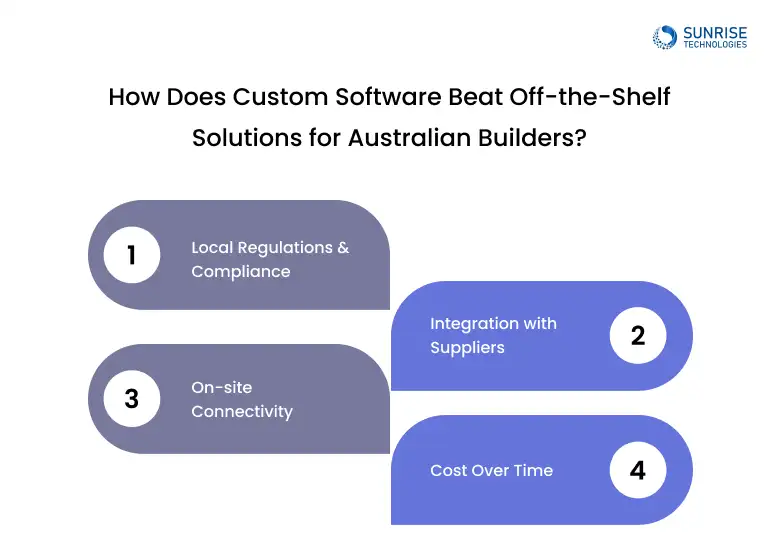
Nowhere is this clearer than in construction and trades. Off-the-shelf project management or quoting apps may promise “plug and play,” but Aussie builders quickly hit walls:
- Local Regulations & Compliance: Many generic platforms don’t align with Australian Building Codes or state-based compliance reporting. A custom solution can auto-generate compliance documents in seconds.
- Integration with Suppliers: Builders work with local suppliers who may not be on global software APIs. Custom solutions ensure the software talks directly with supplier systems — reducing delays.
- On-site Connectivity: Aussie job sites often have patchy internet. Off-the-shelf apps that demand cloud-first access fail here. Bespoke mobile apps can be built offline-first and sync later.
- Cost Over Time: While a $30/month tool looks cheap, once multiplied across 50 staff, plus missing feature workarounds and inefficiency gaps, costs quickly balloon.
Example: A Perth-based builder we spoke to ditched their US-based SaaS because it didn’t handle Australian GST properly. After shifting to a Sunrise Technologies custom software solution, they automated tax compliance and reduced project reporting time by 65%.
Off-the-shelf software is like buying a one-size-fits-all jacket. It covers you, but it never quite fits. Custom software is tailored — and for builders, that perfect fit means jobs done faster, fewer mistakes, and more projects completed each year.
Is It More Cost-Effective to Integrate AI Into Existing Systems or Rebuild from Scratch?
This is one of the hottest questions SMEs are asking right now.
The truth? It depends on your systems.
- If your current systems are modern and API-friendly, you can usually integrate AI development services cost-effectively. For example: adding AI-powered chatbots, predictive analytics, or workflow automation.
- But if your core system is a decade old, clunky, and can’t talk to anything — then forcing AI into it is like bolting a Tesla battery onto a 1998 Holden. In those cases, a rebuild is smarter and cheaper long-term.
At Sunrise Technologies, our AI development team often runs an AI readiness assessment for SMEs, checking:
- Can your system handle AI integration without slowing down?
- Do you need custom AI development solutions for specific workflows?
- Would a full rebuild with AI-first architecture be more cost-effective in 3–5 years?
Example: A mid-sized Australian retail SME wanted AI for inventory forecasting. Their ERP was too outdated. Instead of patching it, we built a custom software solution with AI forecasting — ROI hit in under 14 months, and it scaled seamlessly.
So… Is Custom Software Worth It for Australian SMEs?
Custom software isn’t cheap upfront, but SMEs need to think like investors, not shoppers.
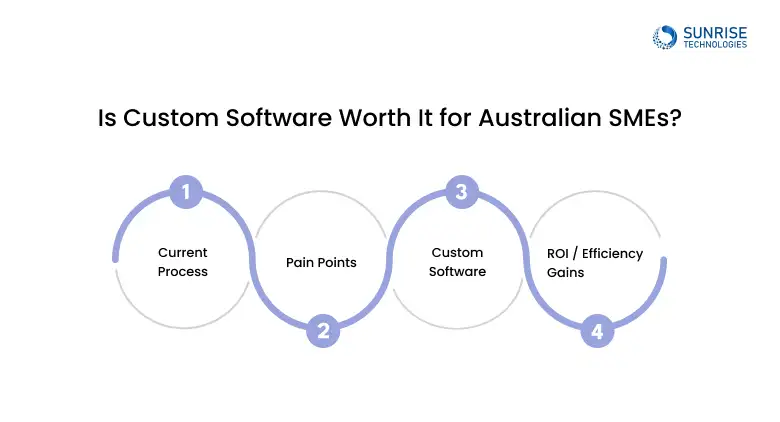
When done with the right software development company, like Sunrise Technologies, the long-term payback outshines the upfront sticker shock.
Ask yourself:
- How much time do my people waste every week on repetitive tasks?
- How many customers churn because of delays, errors, or poor digital experiences?
- How much do I spend on 5 different SaaS subscriptions when one custom solution could consolidate them?
- How many growth opportunities am I missing because my tools don’t scale?
For most SMEs, the math works out. Within 18–30 months, well-designed bespoke solutions typically outperform SaaS in ROI. Add in the fact that you own the IP (instead of renting tools forever), and the long-term value becomes obvious.
The only caveat? Choose a partner who understands not just tech, but the Australian SME ecosystem — from compliance, to customer expectations, to industry quirks. That’s where Sunrise Technologies has built its reputation as a trusted software development company in Perth and across Australia.
Keep your custom software running smoothly after deployment. Our team ensures updates, fixes, and support—on the house.
The Future: AI-Powered Custom Software Solutions
Here’s where things get exciting. SMEs no longer need to ask: “Should we use AI?” The smarter question is: “Where should we integrate AI into our software?” With AI development services, SMEs can:
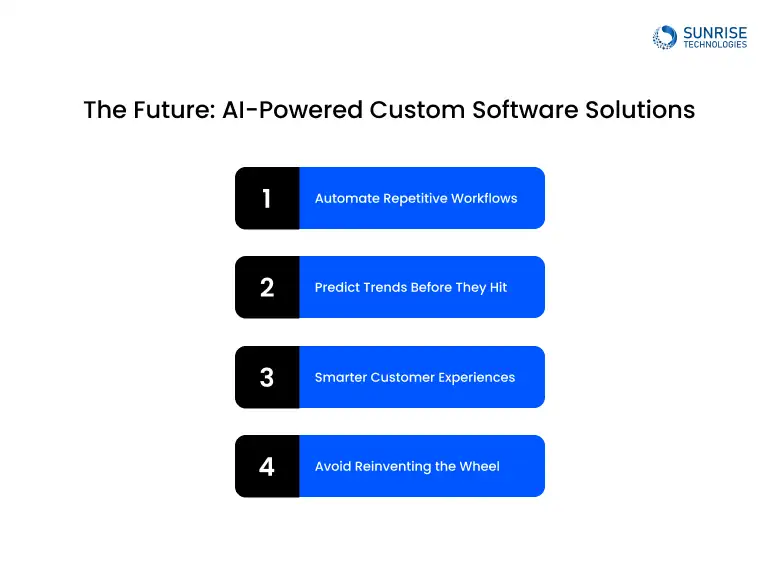
- Automate Repetitive Workflows: Think invoice processing, rostering, payroll classification. AI can reduce manual admin by 60–70%.
- Predict Trends Before They Hit: Retail SMEs can forecast demand. Builders can anticipate supply shortages. Service firms can predict churn.
- Smarter Customer Experiences: AI chatbots trained on your own data can handle client queries 24/7, cutting response times from hours to seconds.
- Avoid Reinventing the Wheel: Often, SMEs assume they must scrap legacy systems to get AI. That’s not true. AI can be layered on top of existing ERP, CRM, or booking systems — making it more cost-effective to integrate AI into existing systems than to start from scratch.
Example: A WA-based SME in logistics saved $120K a year by integrating AI-powered route optimisation into their existing fleet software — instead of buying a new system altogether.
Sunrise Technologies’ AI development solutions are designed this way — to maximise SME ROI by enhancing what you already have, rather than forcing expensive rebuilds.
Final Thoughts: Is Custom Software Really Worth It for Australian SMEs?
Australian SMEs can’t afford to rely on outdated manual processes or rigid off-the-shelf systems anymore. The businesses thriving today are the ones that:
- Calculate ROI clearly—knowing every dollar spent on software has a measurable return.
- Invest in tailored solutions that give them an edge over competitors stuck with cookie-cutter tools.
- Avoid common pitfalls like cost overruns by partnering with the right development team.
- Leverage AI-powered custom software solutions to future-proof their operations and tap into automation, predictive insights, and smarter decision-making.
The real question isn’t whether custom software is worth it—it’s whether your business can afford to ignore it. In a market as competitive and fast-moving as Australia’s, standing still means falling behind. At Sunrise Technologies, we’ve helped Australian SMEs—across industries from construction to retail to healthcare—transform how they work with custom software development, mobile app solutions, and AI-powered platforms. Our role isn’t just writing code; it’s making sure your investment pays off, without overruns or hidden surprises.
If you’re ready to explore what custom software could do for your business, let’s start with a free strategy call. Together, we’ll look at your current processes, identify hidden ROI opportunities, and map out the smartest way forward—whether that’s building from scratch or enhancing what you already have. Custom software isn’t just a cost. It’s an investment in efficiency, growth, and long-term resilience. And the sooner you start, the sooner you get ahead.
Common risks include scope creep, unclear requirements, and underestimating user adoption challenges. Working with an experienced Australian development team that offers ongoing support, change management, and clear documentation can mitigate these risks.
Unlike off-the-shelf tools, well-built custom software is designed with scalability in mind. You can add modules, features, and integrations as your business evolves—making it a future-proof investment instead of a short-term patch.
AI doesn’t just automate—it predicts. For example, in construction, AI can forecast project delays; in retail, it can predict buying trends; in healthcare, it can identify patient risks earlier. Australian SMEs that adopt AI within their custom software stack gain data-driven foresight that off-the-shelf tools rarely provide.
Unlike global SaaS tools that may host data offshore, custom software can be designed to align with Australian Privacy Principles (APPs) and industry-specific regulations. This ensures data sovereignty, lowers legal risk, and builds trust with clients who demand local compliance.
Yes. Many Australian manufacturers and logistics firms are embedding IoT sensors into custom platforms to monitor equipment health, fuel usage, or asset location in real-time. When layered with AI, these systems move from reactive to predictive—cutting downtime and optimising resource allocation.
Future-proofing comes from modular architecture and API-first design. A well-structured custom system lets you plug in emerging technologies—AI, blockchain, IoT—without rebuilding from scratch. This makes your software adaptable to future market changes and customer expectations.
Sam is a chartered professional engineer with over 15 years of extensive experience in the software technology space. Over the years, Sam has held the position of Chief Technology Consultant for tech companies both in Australia and abroad before establishing his own software consulting firm in Sydney, Australia. In his current role, he manages a large team of developers and engineers across Australia and internationally, dedicated to delivering the best in software technology.
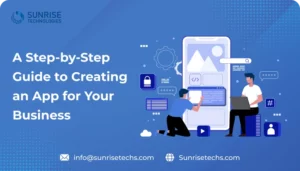

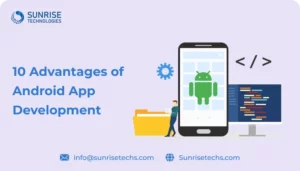
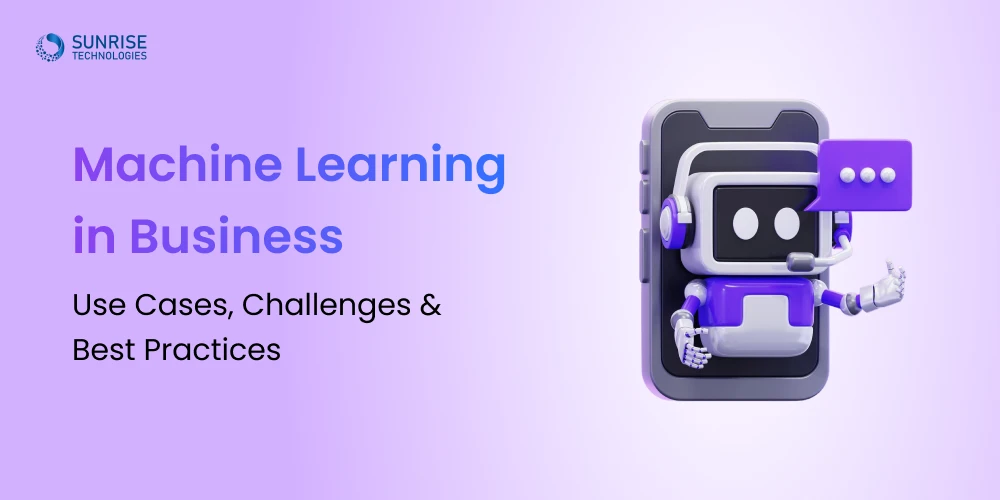
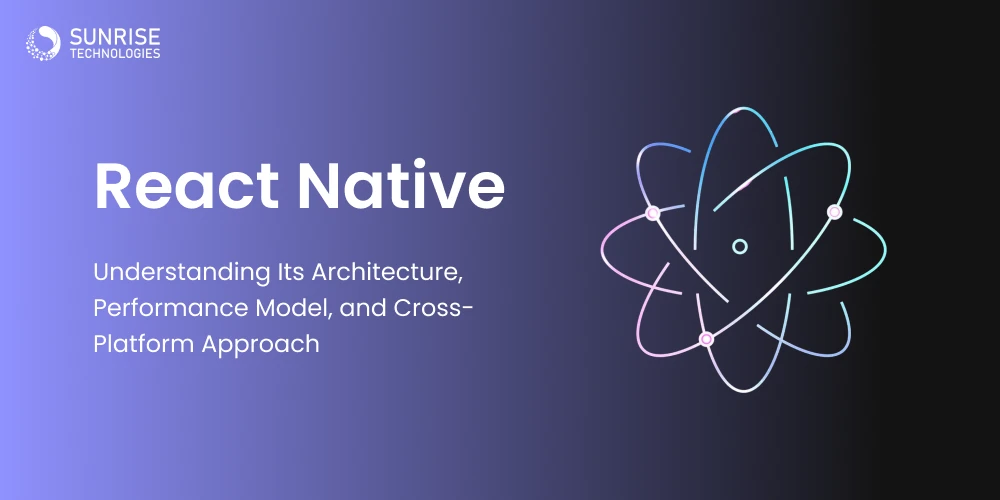
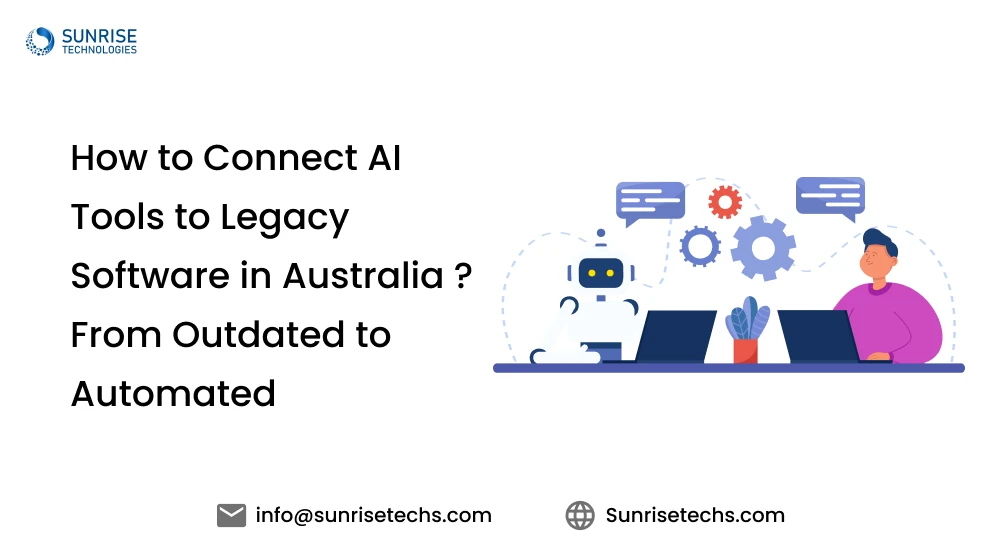
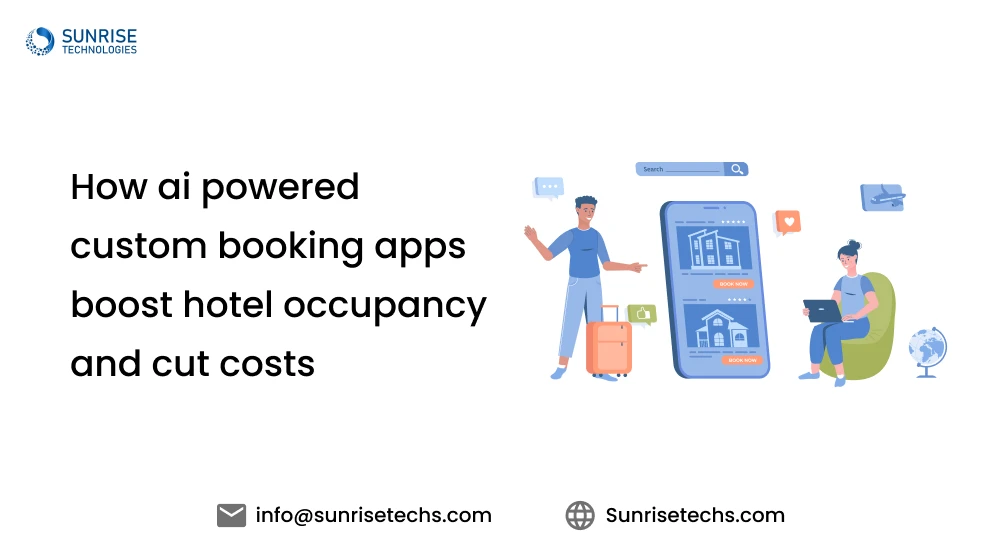
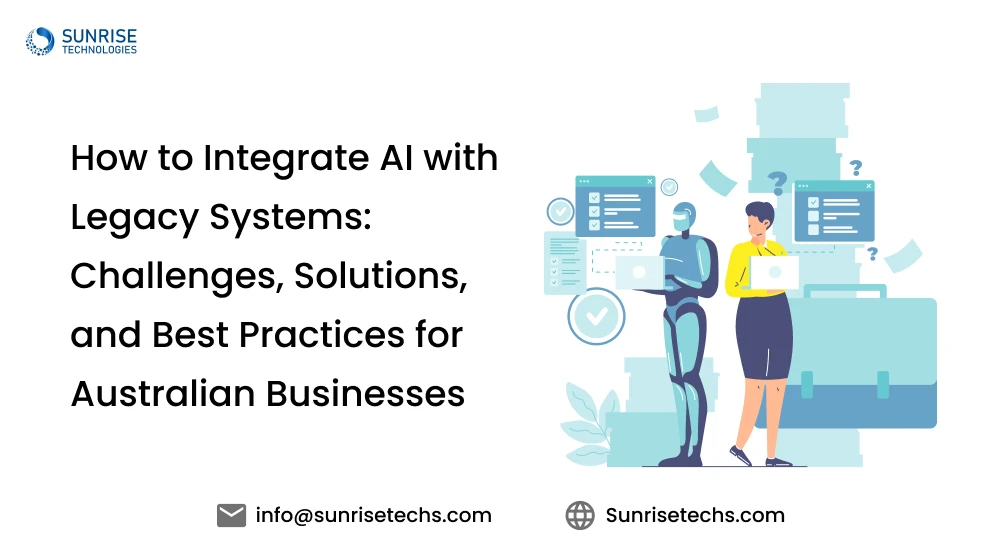

Cloud Based Project Management Platform
Read the challenges we faced and how we helped
View Case Study












